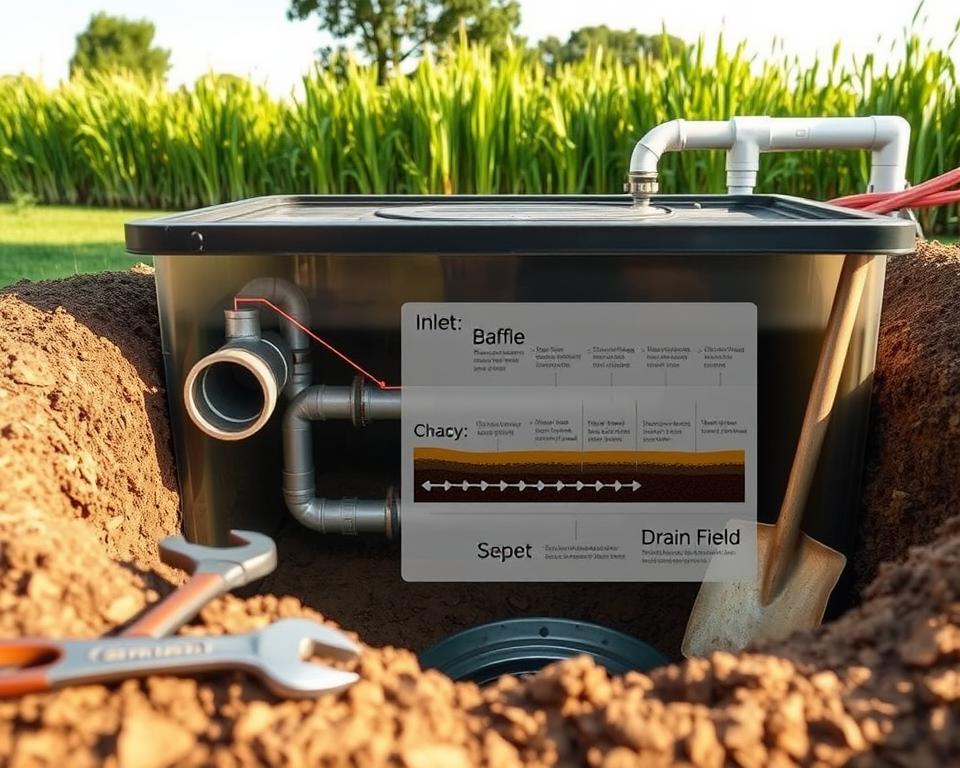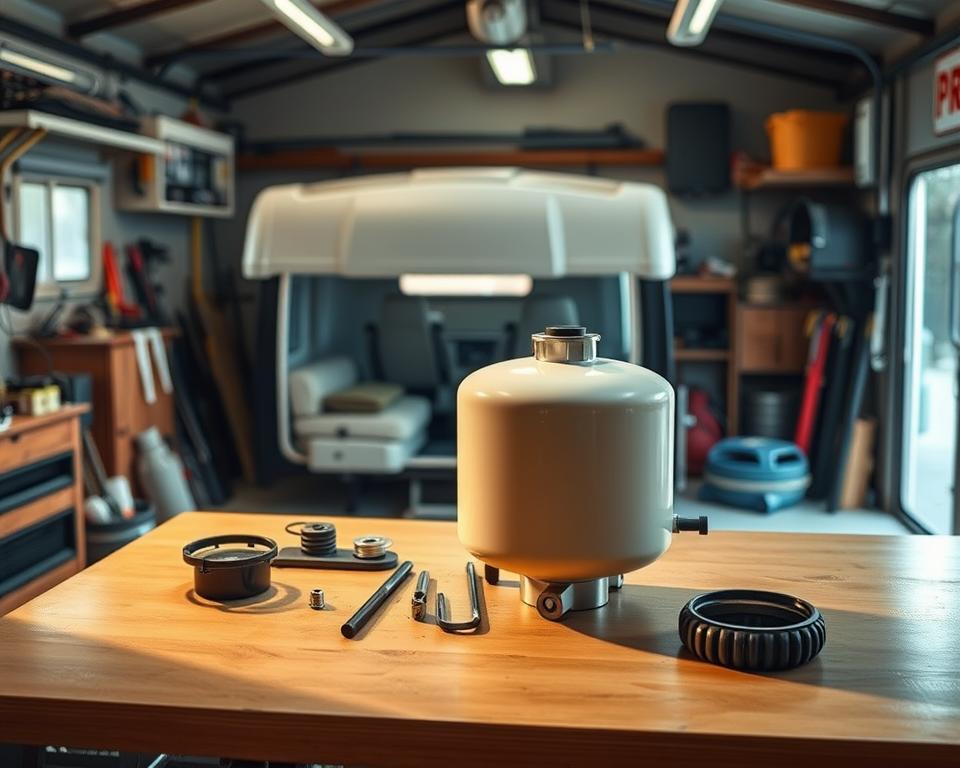Septic Air Pump: Essential Guide for Residential Users
Do you sometimes think about what drives your aerobic septic system’s performance? The Septic tank aerator is the unrecognized hero integral for your system. With this resource, property owners will get useful information on the device’s function. It’s necessary for a well-functioning, efficient Septic tank.
Appreciating the significance of a Septic tank air Pump can boost your Septic system’s functionality using septic tank cleaning companies. It also preserves your home equity and environmental health. Our handbook will highlight All in Sanitation, a trusted Septic industry leader. They’re eager to handle your Septic aerator Pump requirements.
Top Highlights
- The Septic air Pump is crucial for aerated wastewater units.
- Servicing your Septic system air Pump can optimize overall system performance.
- Routine inspections lengthen the service life of your Septic tank air Pump.
- Choosing the right Septic aerator Pump is essential for top operation.
- All in Sanitation offers expert services for Septic air Pump requirements.
Breaking Down Aerobic Septic Solutions
Aerobic Septic systems deliver a higher-efficiency waste treatment option by supplying oxygen. This method features aerobic bacteria thriving in well-oxygenated environments. These bacteria are highly effective in decomposing organic matter. With the help of Septic aerator Pumps, these systems ensure a steady oxygen supply, boosting the waste decomposition process.
These systems shine in decreasing sludge buildup, owing to the effectiveness of aerobic bacteria. This reduction in solid waste means fewer service calls and tank Pump-outs is required. Additionally, they efficiently treat wastewater, producing reduced odors. This yields a healthier environment for homeowners and the community alike.
To ensure these systems operate successfully, it’s essential to recognize the key Septic system components. These include the Septic tank, aeration chamber, and effluent Pump. Each section has a crucial role, especially the air Pump. It pushes oxygen into the tank, crucial for the aerobic bacteria’s efficiency.
Value of the Septic Air Pump
The Septic air Pump is key in the performance of aerobic Septic systems. It operates as the system’s “oxygen source,” pushing the needed oxygen mandatory. This oxygen allows aerobic bacteria to thrive and process waste effectively. If the Pump breaks, the system’s capability diminishes, resulting in sludge accumulation and possible odors.
Such issues can interfere with Septic system operations and lead to environmental hazards. By acknowledging how essential the Septic air Pump is, homeowners can move early. They can ensure its peak function through consistent upkeep. This wards off failures, sidesteps costly repairs, and keeps the aerobic system’s condition.
Top Advantages of Using a Septic Air Pump
Operating a Septic air Pump significantly boosts the capability of Septic systems. Septic air Pumps are vital as they accelerate the digestion of waste. This is done by oxygenating the treatment process, supporting aerobic bacteria growth. These bacteria are necessary for proper waste treatment.
They’re also useful in cutting foul smells. Due to more active aerobic processes, waste is treated faster, thus cutting down odors. This makes the environment more pleasant for homeowners.
Another noteworthy benefit is the cut in sludge collection. Consequently, tanks necessitate less frequent Pumping, reducing both money and time. Greater processing not only saves costs but also lengthens the lifespan of the drain field.
Servicing these Pumps correctly means fewer repair costs and satisfying regulatory standards. Thus, the benefits of Septic air Pumps are not only for homeowners. They also benefit environmental health by improving waste management practices.
| Benefit | Description |
|---|---|
| Fast Waste Breakdown | Enhanced aerobic activity quickens the decomposition process. |
| Minimized Odor Emissions | Optimized treatment efficacy creates fewer odors. |
| Reduced Sludge Buildup | Fewer Pumping and maintenance are called for. |
| Extended Drain Field Life | Better treatment means a healthier drain field. |
| Cost Savings | Lower probability of repairs and regulatory compliance cost. |

Picking an Ideal Septic Air Pump
Opting for the right Septic air Pump is vital for an well-running aerobic system. Homeowners must consider various factors for the best fit. The size of the tank and the airflow specifications play a crucial role the Pump’s effectiveness.
To select well, it’s essential to recognize the air Pumps available. There are mainly two types: linear diaphragm Pumps and rotary vane Pumps. Each delivers unique benefits, which should be aligned with your home’s particular demands and daily load.
Energy use also deserves attention. Opting for a Pump that lowers energy use while providing the needed airflow can lead to lower utility bills. Guidance from All in Sanitation consultants can be very helpful. They help ensure the Pump you choose meets your system’s requirements perfectly.
Typical Classes of Septic Air Pumps
Homeowners can decide more effectively by recognizing the different Septic air Pumps available. There are mainly two types: diaphragm Pumps and rotary vane Pumps. Each has its particular functions and benefits.
Diaphragm Pumps, valued for their quiet operation, are popular for residential Septic systems. They maintain energy efficiency while ensuring stable air output. Their reliable performance suits smaller systems, attracting many homeowners.
Rotary vane Pumps, however, are designed for bigger or commercial systems. These Pumps provide increased power, required when handling bigger loads. Their robust build guarantees efficient operation in extensive Septic systems.
| Type of Pump | Best Use | Advantages |
|---|---|---|
| Diaphragm Pumps | Residential Systems | Quiet operation, energy-efficient, reliable air flow |
| Rotary Vane Pumps | Larger or Commercial Systems | Powerful performance, high capacity, durable construction |
Knowing the distinctions in Septic air Pumps is key for upgrades or replacements. Each Pump type provides unique qualities to address various needs. This provides optimal performance for any system.
Indicators You Require a Septic Air Pump Replacement
Homeowners must monitor Pump failure signs in their Septic systems. Some signals suggest the need for a Septic air Pump replacement. These keep the system running smoothly. Noticing these quickly prevents bigger issues.
Signs of potential problems include:
- Unusual noises from the Pump, like scraping or vibrating, might suggest internal damage.
- A clear lack of air output indicates the Pump isn’t functioning properly, reducing efficiency.
- Ongoing electrical problems, such as circuit trips or voltage drops, could show overloading.
- Visible damage on the Pump unit, with splits or leaks, needs quick action.
- Foul odors in the yard often indicate a compromised Pump, highlighting ineffective effluent aeration.
Detecting these signs early avoids pricey restoration or total system failure. Carrying out periodic reviews helps identify these issues. It also clarifies if you require a new Septic air Pump.
Care Guidelines for Your Septic Air Pump
For an optimal Septic air Pump, regular maintenance is necessary. This ensures that your system operates correctly. Homeowners can follow several straightforward care strategies for peak results.
Bi-annually, perform a careful inspection for wear or damage. It is also crucial to replace the filters as indicated. This reduces clogs that could hurt efficiency.
The Pump should be placed on a solid base to lessen vibrations, which could wear it over time. A protective cover is essential too. It defends against debris and water, keeping the Pump’s functionality.
Proper maintenance can significantly prolong the life of your Pump. In turn, this enhances the Septic system’s performance in general.
| Maintenance Task | Frequency | Benefits |
|---|---|---|
| Inspect Pump for damage | Every 6 months | Detects damage sooner |
| Replace filters | As needed | Enhances operation |
| Check surface stability | Annually | Minimizes shake |
| Clear debris around Pump | Monthly | Avoids obstruction |
Placing Your Septic Air Pump
Correct installation of your Septic air Pump is essential for its smooth operation. First, find a reliable, moisture-free area for placement. The chosen spot should securely support the Pump’s weight without strain.
To properly fit your Pump on your own, heed the following guidelines:
- Gather all necessary items, including the Pump, a power source, and hose fittings.
- Thoroughly review the manufacturer’s guidelines before kicking off your installation.
- Make sure every connection is sealed to prevent air leaks that hurt performance.
- After assembly, conduct a test to confirm the system works as intended.
If the installation process feels tricky, call All in Sanitation. Their professionals can avoid common errors, ensuring your setup follows necessary safety requirements.
Benefits of Choosing All in Sanitation for Your Septic Air Pump Needs
When selecting a Septic service provider, the choice is key. All in Sanitation distinguishes itself by supplying dependable Septic air Pumps. They serve wide-ranging homeowner requirements with a wide selection of quality products. This ensures customers secure an appropriate match for their Septic systems.
What truly separates All in Sanitation is not solely their extensive product lineup. Their dedication to outstanding customer service is just as important. Homeowners receive specialist insight, guiding them towards trusted Septic solutions. This partnership is crucial to adapt each solution to meet specific needs.
All in Sanitation also focuses on aftercare to guarantee lasting satisfaction. Their devotion continues beyond the initial sale. They provide ongoing support to preserve Septic systems operating efficiently for the years ahead.
Expense Overview for Septic Air Pumps
Knowing the costs connected with Septic air Pumps is vital for homeowners with aerobic Septic systems. Initially, one faces the purchase price, which includes the Pump and necessary accessories. Installation expenses fluctuate, depending on the system’s complexity and any alterations required.
Ongoing upkeep forms an additional cost layer. Regular inspections can ward off bigger issues, in the long run yielding savings. Homeowners should set aside funds for Septic maintenance to keep the Pump’s effectiveness and durability. Such planning avoids expensive repairs later on, showing the advantage of proactive maintenance.
| Cost Component | Average Cost Range |
|---|---|
| Septic Air Pump | $500 – $1,200 |
| Installation | $300 – $800 |
| Annual Maintenance | $150 – $400 |
| Potential Repair Costs | $1,000 – $5,000 |
Dividing Septic air Pump expenses into distinct parts helps homeowners in budget planning. This comprehensive approach provides the system’s smooth operation and their comfort.
To Conclude
For homeowners with aerobic Septic systems, maintaining Septic units is crucial. The appropriate Septic air Pump improves waste processing and extends your system’s life. Sticking with ongoing care and immediately resolving issues sidesteps expensive repairs and disruptions.
Opting for a Septic air Pump calls for consideration. This guide highlighted how to decide intelligently about installation and replacement. With All in Sanitation’s help, you can navigate your Septic systems’ complexities with confidence.
Attending to your Septic air Pump improves your system’s performance and service life. It secures a efficient and optimal operation over time. Don’t forget, your home’s wastewater management is greatly improved by ongoing maintenance.


